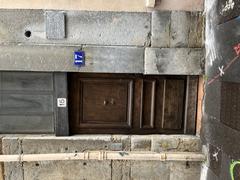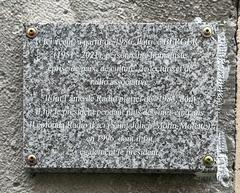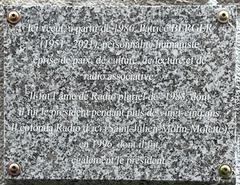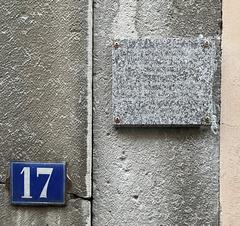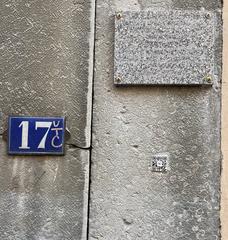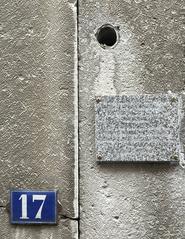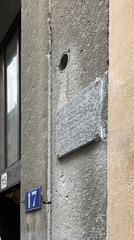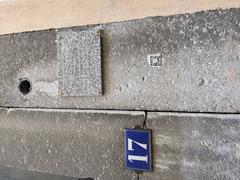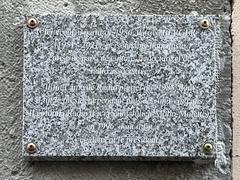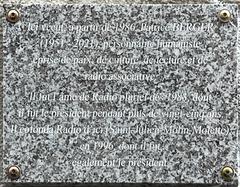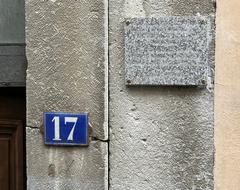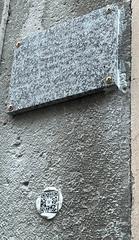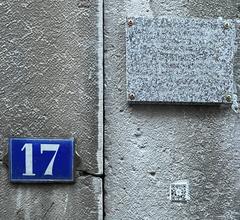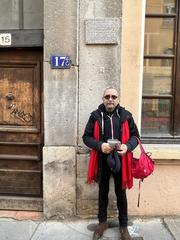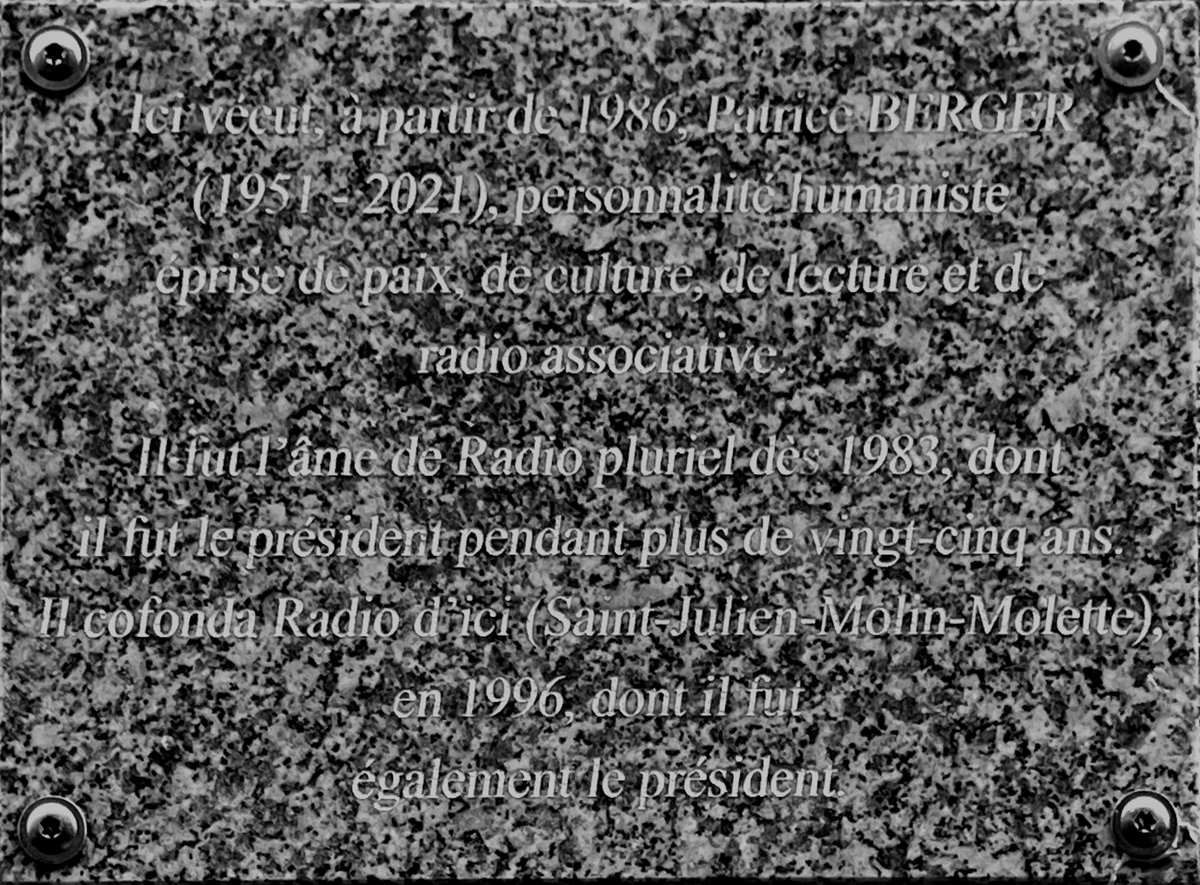
Plaque to Patrice Berger in Lyon: Visiting Hours, Tickets, and Historical Insights
Date: 14/06/2025
Introduction
Lyon, France’s third-largest city, is celebrated for its deep-rooted history and vibrant tradition of commemorating its past, particularly its pivotal role during World War II and its ongoing civic activism. Among the city’s many commemorative sites, the Plaque to Patrice Berger stands out as a moving tribute to both a young French Resistance hero and a champion of media pluralism and social engagement.
Located in the historic Croix-Rousse district—a neighborhood famed for its working-class heritage and its legacy of resistance—the Plaque to Patrice Berger is publicly accessible at 15-17 rue du Bon Pasteur. This guide provides detailed information for visitors including the plaque’s historical context, precise location, accessibility, visiting hours, and practical tips. It also highlights nearby attractions such as the Centre d’Histoire de la Résistance et de la Déportation (CHRD), the traboules, and cultural sites like Radio Pluriel and Parc de la Tête d’Or, ensuring a comprehensive and respectful visit.
Whether you are a history enthusiast, a cultural explorer, or a Lyonnais interested in your city’s legacy, this article will help you plan a meaningful visit to the Plaque to Patrice Berger. To further enrich your experience, consider utilizing digital resources such as Memospace.fr, the Lyon Tourist Office, and the Audiala app for interactive maps, audio guides, and in-depth historical context.
Embark on a reflective journey through Lyon’s commemorative landscape and discover the enduring spirit of resistance, community, and remembrance. (JGuide Europe: Lyon, CHRD Lyon, Travel to Lyon)
Contents
- The Historical Significance of Lyon’s Commemorative Plaques
- The Plaque to Patrice Berger: Historical Context and Symbolism
- Location, Accessibility, and Visiting Information
- Enhancing Your Visit: Nearby Attractions and Thematic Trails
- Practical Visitor Tips
- Frequently Asked Questions (FAQs)
- Summary and Recommendations
- Sources and Further Reading
The Historical Significance of Lyon’s Commemorative Plaques
Lyon is renowned for its network of commemorative plaques, which serve as enduring reminders of the city’s experiences during World War II and its critical role in the French Resistance. These plaques, found throughout city streets and public spaces, honor Resistance fighters, deportees, and civilians impacted by Nazi occupation. They form a “memory map” that weaves personal stories into Lyon’s broader historical tapestry.
The Plaque to Patrice Berger is one of many markers that collectively highlight Lyon’s commitment to remembrance and education, ensuring that the sacrifices and achievements of individuals remain visible within the city’s urban fabric.
The Plaque to Patrice Berger: Historical Context and Symbolism
Historical Background
The Plaque to Patrice Berger commemorates a courageous member of the French Resistance who was executed during World War II. Lyon, often dubbed the “Capital of the Resistance,” provided vital refuge and escape routes for anti-Nazi fighters, thanks in part to its labyrinthine traboules and discreet meeting spots (Wikipedia: Lyon).
Although detailed biographical information about Patrice Berger is limited, the plaque stands as a testament to his bravery and the many who fought for freedom. It symbolizes both personal sacrifice and the collective memory of a city deeply marked by the events of the 20th century (JGuide Europe: Lyon).
Symbolism
The plaque’s presence in the Croix-Rousse district—a historic hub for working-class activism and resistance—amplifies its significance. It serves not only to commemorate Berger’s legacy but also to:
- Honor those who fought and died for liberty.
- Educate the public about Lyon’s wartime experiences and the enduring values of resistance.
- Offer a place of reflection on the cost of freedom and the ongoing fight against injustice.
Other major memorials in Lyon, such as the Centre d’Histoire de la Résistance et de la Déportation (CHRD) and the Montluc Prison National Memorial, reinforce the city’s dedication to remembrance (CHRD Lyon, Montluc Memorial).
Location, Accessibility, and Visiting Information
Exact Location
- Address: 15-17 rue du Bon Pasteur, 69001 Lyon, France (Mapcarta: Plaque à Patrice Berger)
- District: Croix-Rousse, 1st arrondissement
The plaque is affixed to a residential building in one of Lyon’s most atmospheric and historically significant neighborhoods.
Accessibility
- Public Transport: Nearest metro station is Croix-Rousse (Line C), followed by a short walk.
- On Foot/Bike: The area is pedestrian-friendly and accessible via Lyon’s Vélo’v bike-sharing system.
- Mobility: While the Croix-Rousse district is known for its inclines and cobbled streets, the approach to Rue du Bon Pasteur is generally manageable for most visitors. Wheelchair access is possible on main streets, though some paths may be challenging.
Visiting Hours and Admission
- Visiting Hours: The plaque is outdoors and accessible 24/7, year-round.
- Admission: Free. No ticket is required.
Visitor Etiquette
- Approach the site with respect, as it is a place of remembrance.
- Photography is permitted; please be discreet and mindful of residents.
- Do not leave objects such as flowers or candles unless authorized.
Enhancing Your Visit: Nearby Attractions and Thematic Trails
Key Sites Nearby
- Centre d’Histoire de la Résistance et de la Déportation (CHRD): Lyon’s main Resistance museum with exhibitions on wartime history (CHRD Lyon).
- Montluc Prison National Memorial: Former Gestapo prison, now a site of remembrance (Montluc Memorial).
- Traboules of Croix-Rousse: Historic passageways integral to the Resistance (The Crazy Tourist: Traboules).
- Maison des Canuts: Museum on Lyon’s silk-weaving heritage.
- Place des Terreaux: Iconic square with the Museum of Fine Arts.
- Parc de la Tête d’Or: Expansive city park hosting cultural events like the “Dialogues en Humanité” festival (Dialogues en Humanité Festival).
Thematic Trails
- Urban Trail: “Secret Places of the Resistance” (JGuide Europe: Urban Trail)
- In the Footsteps of Jean Moulin: Explore sites linked to Lyon’s most renowned Resistance leader (JGuide Europe: Jean Moulin Tour).
Guided Tours
The Lyon Tourist Office and local historical societies offer walking tours that include the Plaque to Patrice Berger and other commemorative sites. These tours provide expert insights and often highlight photographic opportunities (Lyon Tourist Office).
Practical Visitor Tips
- Language: Most plaques are inscribed in French. Bring a translation app or guide for deeper understanding.
- Best Time to Visit: Late spring to early autumn (May–September) for pleasant weather and city events (Travellers Worldwide).
- Accessibility: Main streets are wheelchair accessible; some cobbled areas may pose challenges.
- Dress and Footwear: Comfortable shoes are recommended due to uneven pavements.
- Amenities: Cafés, bakeries, and public restrooms are conveniently located throughout Croix-Rousse.
Frequently Asked Questions (FAQs)
Q: Where exactly is the Plaque to Patrice Berger located?
A: 15-17 rue du Bon Pasteur, Croix-Rousse district, Lyon, France.
Q: What are the visiting hours for the plaque?
A: The plaque can be visited at any time, day or night.
Q: Is there an entrance fee or ticket required?
A: No, it is a freely accessible public site.
Q: How do I get there via public transport?
A: Take Metro Line C to Croix-Rousse station, then walk to Rue du Bon Pasteur.
Q: Are there guided tours that include the plaque?
A: Yes, several thematic and historical walking tours include the site.
Q: Is the plaque accessible for visitors with limited mobility?
A: The main streets are generally accessible, though some areas may have cobblestones or slopes.
Q: Can I take photos of the plaque?
A: Yes, but please be respectful of local residents and the memorial’s solemnity.
Summary and Recommendations
The Plaque to Patrice Berger is a poignant symbol of Lyon’s enduring spirit of resistance and commitment to public remembrance. Its location in the Croix-Rousse district connects visitors not just with the story of one Resistance hero, but with the broader currents of activism, diversity, and community that define the city.
With no entrance fees or time restrictions, the site is accessible to all. Its proximity to other key landmarks and museums makes it an ideal stop on any historical or cultural itinerary in Lyon. To maximize your visit, consider exploring nearby attractions, joining a guided tour, or using digital resources like the Audiala app for audio guides and interactive maps.
Engaging with the Plaque to Patrice Berger offers a meaningful opportunity to reflect on the importance of civic courage, diversity, and the power of community action—values that continue to shape Lyon today.
Sources and Further Reading
- Memospace.fr: Plaques Commemoratives
- Lyon Tourist Office
- JGuide Europe: Lyon
- ONLYLYON Tourisme
- CHRD Lyon
- Montluc Memorial
- Radio Pluriel
- Dialogues en Humanité Festival
- Travellers Worldwide: Best Time to Visit Lyon
- Travel to Lyon: Best Things to Do
- Mapcarta: Plaque à Patrice Berger
- The Crazy Tourist: Traboules
- Wikipedia: Lyon

